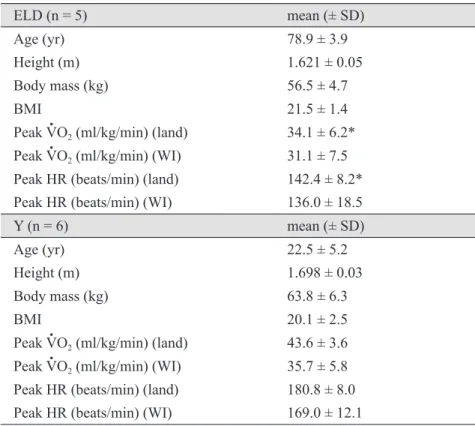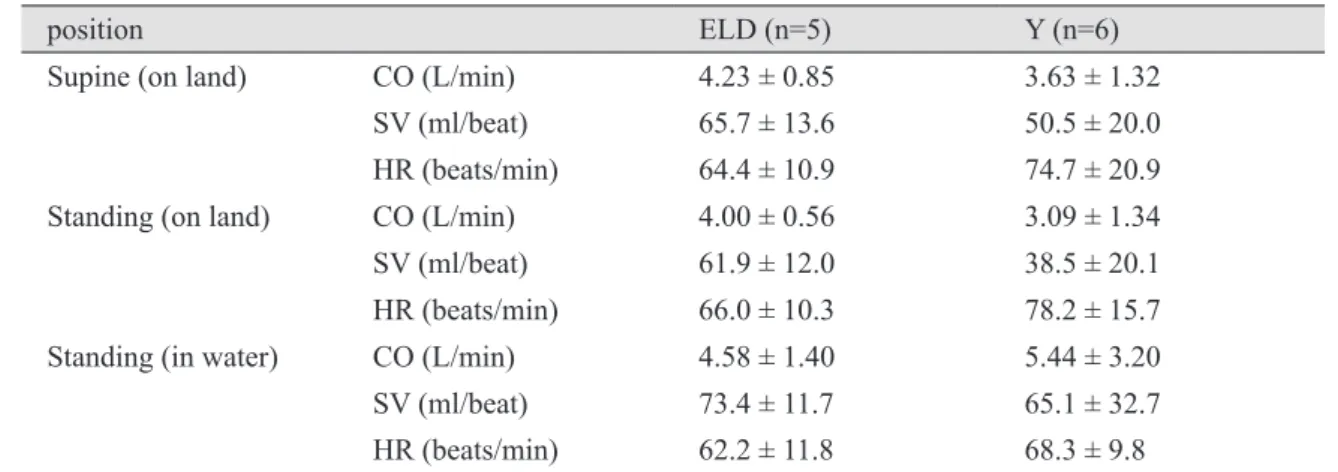Comparison of cardiovascular response to water immersion in elderly during rest and exercise
Nobuo Takeshima *1 , Makoto Narita *2 , Takeshi Matsui *3 , Akiyoshi Okada *4 , Mohammod M. Islam *5 , William F. Brechue *6
Abstract
It is generally accepted that the central redistribution of blood volume with water immersion (WI) leads to an increase in stroke volume (SV). However, little research exists concerning the physiological effects of WI on the cardiorespiratory responses at rest and during dynamic exercise in the elderly. The purpose of this study was to determine the effect of xiphoid-level WI (30˚C) on SV and heart rate (HR) response to graded exercise in elderly (ELD) and young (Y) subjects. Elderly (n = 5 ; 78.4 ± 3.9 yr) and young (n = 6 ; 22.5 ± 5.2 yr) men performed two bouts of incremental exercise on land and in water (water treadmill) separated by one week in random order. Oxygen uptake and left ventricular (LV) end-systolic and end-diastolic volumes (M-mode echocardiography;
Teichholz method) were recorded at rest and during exercise. Resting HR, SV and CO were not different between conditions. Peak HR was greater on land (181 ± 8 beats/min) than during WI (169
± 12 beats/min) for Y, but was not different for ELD (land = 142 ± 8 beats/min; WI = 136 ± 19 beats/min). SV (controlled for CO) and HR (controlled for SV) showed a significant difference (least square means) between land and WI in Y, but not in ELD. The results indicate that age significantly affects the cardiac preload at rest and during WI.
Keywords : Water immersion, Elderly, Water walking, Stroke Volume, Heart rate.
Ⅰ . INTRODUCTION
Walking is the most convenient and common form of exercise for improving and maintaining physical fitness in the elderly. A large number of elderly in Japan and in the United States of America suffer from a myriad of musculoskeletal complications, thus, traditional forms of land- based exercise may be prohibitive. For frail older individuals, water activities have been shown to be therapeutic and beneficial 24, 29) . Water is an equalizing medium; its bouancy provides an optimum exercise environment for patients with arthritis, back problems or other medical conditions where physical loading associated with land exercise may limit or deter exercise and/or may increase the risk of orthopedic injury during land exercise. Therefore, some forms of water exercise may be a better option for many middle-aged and older persons 29) .
It is generally accepted that the central shift in blood volume, with water immersion (WI, head out of water) is due to the hydrostatic pressure gradient that causes a shift of blood volume from the lower limbs to the thoracic region 1, 4, 5, 22, 27) . Previous WI studies showed that increased central
受付日 2018.1.22 / 受理日 2018.3.30


